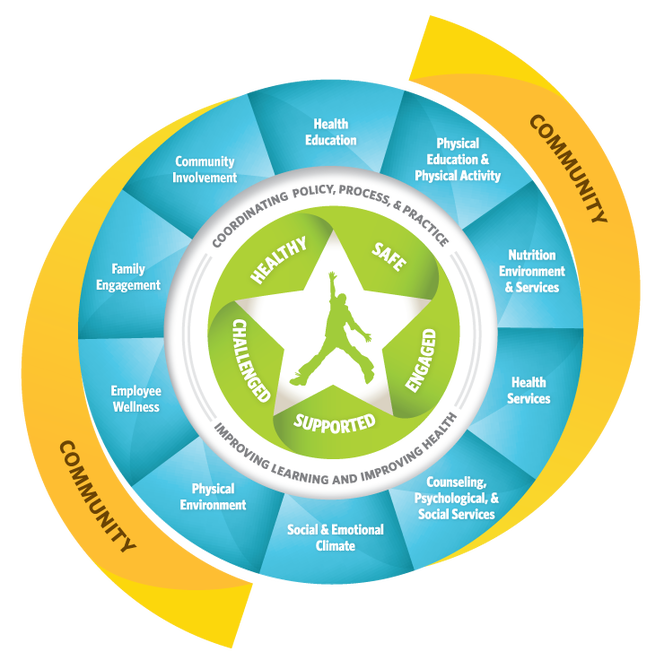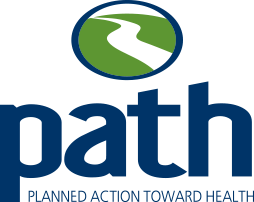PARENTS & STUDENTS
SCHOOL BOARDS
HUMAN RESOURCES
Our wellness initiatives at FWSU are based on the Whole School, Whole Child, Whole Community Framework. The overarching purpose of the WSCC Framework is to establish greater alignment, integration, and collaboration between health and education across the school settings to improve each child's cognitive, physical, social, and emotional development. The ten domains of the WSCC Framework include health education, physical education and physical activity, nutrition environment and services, health services, counseling, psychological and social services, social and emotional climate, physical environment, employee wellness, family engagement, and community involvement.
The Centers for Disease Control and Prevention (CDC) and ASCD have partnered to create the Whole School, Whole Community, Whole Child (WSCC) model. This enhanced model builds upon aspects of the CDC’s familiar Coordinated School Health (CSH) model and the Whole Child framework from the ASCD.
The WSCC Model
Expands upon the 8 domains of the CSH model into the 10 domains shown in the graphic
Combines the CSH model with the ASCD’s Whole Child framework
Demonstrates integration of health and education to improve academic achievement
Promotes increased alignment, integration, and collaboration between health and education in order to achieve improved cognitive, physical, social, and emotional development
Both the Vermont Department of Health (VDH) and the Agency of Education (AOE) are committed to promoting the use of the WSCC model by their school and community partners to improve population health and academic achievement outcomes. The VDH and AOE recommends using the WSCC model to achieve goals outlined in school continuous improvement plans and school wellness policies and integrating it into a multi-tiered system of supports (MTSS).
As updated or new tools become available from the CDC and ASCD, they will be promoted and distributed to schools in a consistent and coordinated manner by the Health Department and the Agency of Education. We encourage you to visit the CDC and ASCD websites for more information (see below).
For more information:
Centers for Disease Control and Prevention:

WSCC Components
Health education: Health education provides students with opportunities to acquire the knowledge, attitudes, and skills necessary for making health-promoting decisions, achieving health literacy, adopting health-enhancing behaviors, and promoting the health of others. Health education should be provided sequentially from pre-K through grade 12. Health education should address important health topic areas through instruction based on the Shape Health Standards.
Physical education and physical activity: Physical education is a school-based instructional opportunity for students to gain the necessary skills and knowledge for lifelong participation in physical activity. Physical education is characterized by a planned, sequential K through 12 curriculum that assists students in achieving the national standards for K through 12 physical education. The outcome of a quality physical education program is a physically educated person who has the knowledge, skills, and confidence to enjoy a lifetime of healthful physical activity (CDC, 2013).
Health services: These services are designed to ensure access or referral to primary health care services; foster appropriate use of primary health care services; prevent and control communicable disease and other health problems; provide emergency care for illness or injury; promote and provide optimum sanitary conditions for a safe school facility and school environment; and provide educational and counseling opportunities for promoting and maintaining individual, family, and community health (CDC, 2013).
Nutrition environment and services: Schools should provide access to a variety of nutritious and appealing meals that accommodate the health and nutrition needs of all students. School nutrition programs should reflect U.S. Dietary Guidelines for Americans and other criteria to achieve nutrition integrity. The school nutrition services should offer students a learning laboratory for classroom nutrition and health education and serve as a resource for linkages with nutrition-related community services (CDC, 2013).
Counseling, psychological, and social services: These services are provided to improve students’ mental, emotional, and social health and include individual and group assessments, interventions, and referrals. Organizational assessment and consultation skills of counselors and psychologists should contribute not only to the health of students but also to the health of the school environment (CDC, 2013).
Physical environment: The physical environment of a safe and healthy school includes buildings, school grounds, playground equipment, and athletic fields. The physical environment within the school includes building design, adequate space, cleanliness, noise level, heating and cooling, ventilation, and restrooms. These interior and exterior areas should be clean; safe; free from environmental hazards, tobacco, drugs, weapons, and violence; and appropriately secure from unauthorized access (Allensworth, Lawson, Nicholson, & Wyche, 1997; ASCD, 2014).
Social and emotional climate: The social and emotional climate of a safe and healthy school should provide a supportive culture conducive to enabling students, families, and staff members to feel safe, secure, accepted, and valued. Important factors in the social and emotional climate of a school include an attractive, comfortable physical environment; appreciation and respect for individual differences and cultural diversity; value placed on equity and social justice; high expectations and supportive actions for learning; size and structure of classes and organizations; and a general sense of comfort and safety (Allensworth, Lawson, Nicholson, & Wyche, 1997).
Health promotion for staff: Schools can provide opportunities for school staff members to improve their health and wellness status through activities such as health assessments, health education, health-related nutrition and fitness activities, and stress reduction. These opportunities should encourage staff members to pursue a healthy lifestyle that contributes to their improved health status, improved morale, and a greater personal commitment to the school’s overall coordinated health approach (CDC, 2013).
Family engagement: Epstein et al. (2009) identified six types of involvement necessary for successful school and family partnerships: (1) providing parenting support, (2) communicating with parents, (3) providing diverse volunteer opportunities, (4) supporting at-home learning, (5) encouraging parents to engage in decision-making opportunities in schools, and (6) collaborating with the community. Engaging family members often involves overcoming challenges such as family time conflicts, lack of transportation to school, and lack of comfort among family members in engaging in school activities. In addition, teachers and school staff may lack adequate time and resources to work with families.
Community involvement: Meaningful community involvement in the WSCC approach is characterized by systematic collaboration among individuals and organizations within the school community. This systematic collaboration involves the engagement of individuals and organizations representing various segments of the community in the planning, implementation, and evaluation of programs, structures, and systems designed to create and sustain WSCC. The collaboration also involves the sharing of both community and school resources





